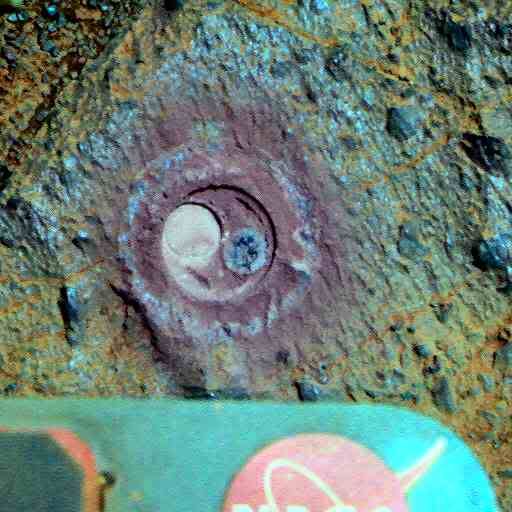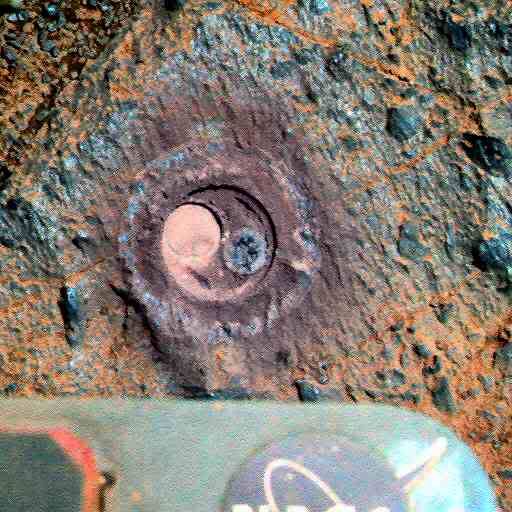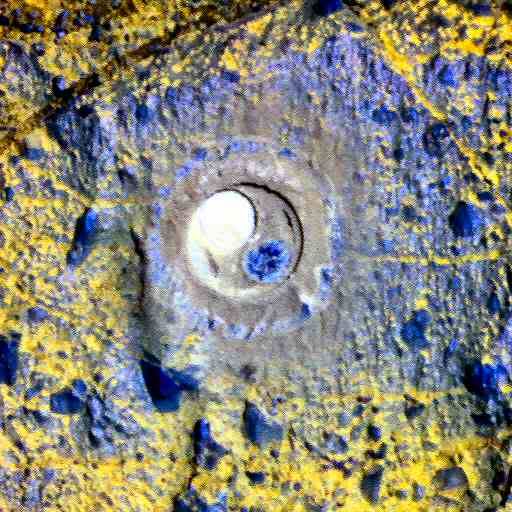Cape York - The "Lakelands", Starting sol 2703 |

  |
Cape York - The "Lakelands", Starting sol 2703 |
 Sep 19 2011, 05:49 PM Sep 19 2011, 05:49 PM
Post
#106
|
|
|
Founder     Group: Chairman Posts: 14431 Joined: 8-February 04 Member No.: 1 |
That is what I initially thought but decided that the surface looked "too glassy" to be deeply weathered. I imagine that the actual criteria for hardness of the rock would be Oppy's RAT engineering telemetry, such as the current draw or the grind time of the operation, and not amount of cuttings. --Bill They have indeed done just that - infer hardness based on RAT performance. If you remember back in the early days - a berry was picked up mid-grind as a spike, and later caused the RAT to stall. |
|
|
|
 Sep 20 2011, 01:28 AM Sep 20 2011, 01:28 AM
Post
#107
|
|
|
Junior Member   Group: Members Posts: 54 Joined: 10-August 11 Member No.: 6119 |
|
|
|
|
 Sep 20 2011, 05:44 AM Sep 20 2011, 05:44 AM
Post
#108
|
|
 Senior Member     Group: Members Posts: 2228 Joined: 1-December 04 From: Marble Falls, Texas, USA Member No.: 116 |
Does that mean it is not basaltic? While fresh basalt is a pretty hard rock, the softness doesn't rule out basalt. If basalt is weathered or altered, especially in the presence of water, it can become quite soft. I think the light color of this rock pretty much eliminates it from having an overall basaltic composition, though the dark, angular rock fragments embedded in the breccia could very well be basalt. The minerals of basalt are very dark in color. The dark blocks of a different breccia lying on top of the nearby hill look very much like basalt. The geology here is fascinating. I can't wait for Opportunity to explore more of Cape York and send back more pictures. That is what I initially thought but decided that the surface looked "too glassy" to be deeply weathered. I imagine that the actual criteria for hardness of the rock would be Oppy's RAT engineering telemetry, such as the current draw or the grind time of the operation, and not amount of cuttings. ... Bill: You are right about the RAT telemetry being the ultimate measure of the rock hardness, but it will be a while before that data will be available...and I won't know how to interpret it when the data is released. My comment on the rock's softness was based solely on depth of the grind. We know that the remaining life of the RAT is a resource the team is trying to conserve for the most important scientific targets, so I would be surprised if they instructed the rover to grind away on this first target without limits. To me, it looks like other soft rocks they have ground into. -------------------- ...Tom
I'm not a Space Fan, I'm a Space Exploration Enthusiast. |
|
|
|
 Sep 20 2011, 05:54 AM Sep 20 2011, 05:54 AM
Post
#109
|
|
 Senior Member     Group: Members Posts: 2228 Joined: 1-December 04 From: Marble Falls, Texas, USA Member No.: 116 |
Tribulation L257 sols 2718 & 20 I really appreciate that you post important information like the sol and the filters used in your images. Some people often neglect to provide that information, and that makes it difficult for others to follow up. -------------------- ...Tom
I'm not a Space Fan, I'm a Space Exploration Enthusiast. |
|
|
|
 Sep 20 2011, 09:14 AM Sep 20 2011, 09:14 AM
Post
#110
|
|
|
Senior Member     Group: Members Posts: 2998 Joined: 30-October 04 Member No.: 105 |
For sure. The surface we are looking at is the product of 3 bln years of deposition, weathering and erosion and each rock fragment tells a story. Some of these rocks are ejectite'd impactites.
There are going to be many profound papers generated from the data at this site. I'm sure that they know precisely what the "hardness" of the rock is from the engineering data, which we in the p'nut gallery are not privy to. Just as they have an idea what mineral is represently by every "RGB color" we see in the Pancams. Even with seriously degraded IDD parts, geologists have made do with scratch plates, acid bottles and rock hammers and calibrated "TLAR"eyeballs for decades for mineral identification. The first thing they are doing on Sol-2722 ("today") is making a FHazcam assessment of the RAT teeth("frhaz_RAT_bit_check_subframe") and getting ready to do chemistry ("front_haz_idd_apxs_doc"). Having snagged the post-grind Pancams of Salisbury1 from the 0:35 Data Express and done my preliminary oooh-ing and ahhh-ing, I'm hitting the sack again... yawnn --Bill -------------------- |
|
|
|
 Sep 20 2011, 10:18 AM Sep 20 2011, 10:18 AM
Post
#111
|
|
|
Member    Group: Members Posts: 293 Joined: 22-September 08 From: Spain Member No.: 4350 |
|
|
|
|
 Sep 20 2011, 11:19 AM Sep 20 2011, 11:19 AM
Post
#112
|
|
|
Senior Member     Group: Members Posts: 2998 Joined: 30-October 04 Member No.: 105 |
Couldn't get my beauty rest, I ended up working on the new images. Note the implication of different mineralogy-- the RAT cuttings are purplish or gray, instead of the usual ochre or blue.
   --Bill -------------------- |
|
|
|
 Sep 20 2011, 03:10 PM Sep 20 2011, 03:10 PM
Post
#113
|
|
 Senior Member     Group: Moderator Posts: 3431 Joined: 11-August 04 From: USA Member No.: 98 |
|
|
|
|
 Sep 20 2011, 03:30 PM Sep 20 2011, 03:30 PM
Post
#114
|
|
|
Founder     Group: Chairman Posts: 14431 Joined: 8-February 04 Member No.: 1 |
All that different to earlier grindings?
http://marsrovers.jpl.nasa.gov/gallery/pre...1-B041R1_br.jpg |
|
|
|
 Sep 20 2011, 05:51 PM Sep 20 2011, 05:51 PM
Post
#115
|
|
|
Senior Member     Group: Members Posts: 2998 Joined: 30-October 04 Member No.: 105 |
Good example. This is the first RAT done in Eagle Crater on Sol-36.
More difference than 21km and 2+ Billion years... --Bill -------------------- |
|
|
|
 Sep 20 2011, 06:26 PM Sep 20 2011, 06:26 PM
Post
#116
|
|
|
Solar System Cartographer     Group: Members Posts: 10146 Joined: 5-April 05 From: Canada Member No.: 227 |
It would be interesting to compile a sequence of images showing the RAT holes at different dates - right now we are getting that small circle inside the larger one, which was not seen in the first hole. When did it start looking like that?
Phil -------------------- ... because the Solar System ain't gonna map itself.
Also to be found posting similar content on https://mastodon.social/@PhilStooke NOTE: everything created by me which I post on UMSF is considered to be in the public domain (NOT CC, public domain) |
|
|
|
 Sep 20 2011, 07:14 PM Sep 20 2011, 07:14 PM
Post
#117
|
|
 Senior Member     Group: Members Posts: 2173 Joined: 28-December 04 From: Florida, USA Member No.: 132 |
... right now we are getting that small circle inside the larger one, which was not seen in the first hole.... My guess is, that's what happens when the two grinding wheels are not rotated around each other. "Two grinding wheels rotate at high speeds. These wheels also rotate around each other at a much slower speed so that the two grinding wheels sweep the entire cutting area." http://marsrover.nasa.gov/mission/spacecraft_instru_rat.html |
|
|
|
 Sep 20 2011, 07:47 PM Sep 20 2011, 07:47 PM
Post
#118
|
|
|
Newbie  Group: Members Posts: 4 Joined: 7-July 09 Member No.: 4857 |
It may be a result of the damage to the RAT brush. At the very least it's not new. I see similar circle-within-a-circle patterns in this RAT hole from Sol 2513.
|
|
|
|
 Sep 20 2011, 08:08 PM Sep 20 2011, 08:08 PM
Post
#119
|
|
|
Senior Member     Group: Members Posts: 2998 Joined: 30-October 04 Member No.: 105 |
The circle-within-a-circle is how the RAT operates. The carbide cutters are on an arm that moves around in a cyclical motion. You can see how it works in the images at the Athena site (the link to the "Honeywell Robotics" RAT site is dead):
http://athena.cornell.edu/the_mission/ins_rat.html After the grind is done the brush is supposed to clear away the cuttings but the brush is kaflooey... You can get an idea of how well it works from this animation: http://images.spaceref.com/news/2004/rover.armspin.mov --Bill -------------------- |
|
|
|
 Sep 20 2011, 08:22 PM Sep 20 2011, 08:22 PM
Post
#120
|
|
|
Solar System Cartographer     Group: Members Posts: 10146 Joined: 5-April 05 From: Canada Member No.: 227 |
Interesting responses! But that's why it would be interesting to collect RAT images throughout the mission to see how the holes have varied in appearance. Anyone? (I don't have time right now)
Phil -------------------- ... because the Solar System ain't gonna map itself.
Also to be found posting similar content on https://mastodon.social/@PhilStooke NOTE: everything created by me which I post on UMSF is considered to be in the public domain (NOT CC, public domain) |
|
|
|
  |

|
Lo-Fi Version | Time is now: 19th April 2024 - 01:03 PM |
|
RULES AND GUIDELINES Please read the Forum Rules and Guidelines before posting. IMAGE COPYRIGHT |
OPINIONS AND MODERATION Opinions expressed on UnmannedSpaceflight.com are those of the individual posters and do not necessarily reflect the opinions of UnmannedSpaceflight.com or The Planetary Society. The all-volunteer UnmannedSpaceflight.com moderation team is wholly independent of The Planetary Society. The Planetary Society has no influence over decisions made by the UnmannedSpaceflight.com moderators. |
SUPPORT THE FORUM Unmannedspaceflight.com is funded by the Planetary Society. Please consider supporting our work and many other projects by donating to the Society or becoming a member. |

|